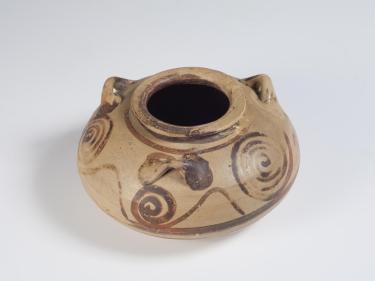Catalogue Entry

This vase is one of a collection of Greek vases held by the CU Art Museum.
Gift to CU Classics Department
Transferred to CU Museum of Natural History
Transferred to CU Art Museum (2006)
Height: 7.0 cm
Diameter (max.): 14.0 cm
Date: 14th century B.C.E.
Origin: Greece
Description: Squat jar with rounded base, short neck, and relatively open mouth. Three small handles evenly spaced around shoulder of vessel. Tan clay with red and brown slip decoration. Bottom of vessel decorated with three pairs of concentric circles in red. Thick red band encircles body just below midpoint. Three large brown spirals fill space between handles, while three smaller brown spirals with curved stems decorate the space beneath each handle. Handles decorated in brown. Top of shoulder decorated with single brown ring just below lip. Neck, lip, and mouth entirely covered with brown slip.
Additional photos of this vessel show details of its base, handles, and decoration.
Discussion
This three-handled squat jar dates to the Late Helladic IIIA:1 period, approximately 1,400-1,375 B.C.E. It is made of a buff-colored clay and is decorated with both reddish and brownish slips. As is typical for this  period, the neck and handles of the jar are decorated in the same solid color (1) and the bottom of the vessel is decorated in a pattern of three pairs of concentric circles (2).
period, the neck and handles of the jar are decorated in the same solid color (1) and the bottom of the vessel is decorated in a pattern of three pairs of concentric circles (2).
Like an earlier squat jar in the CU Art Museum's collection, this vessel likely served as a container for oil and may, therefore, have functioned in connection with cosmetic practices or funeral rituals. The shape is a precursor to the later alabstron shape, seen in a 6th century B.C.E. example in the CU Art Museum's collection, which tend to be taller and thinner with more rounded bottoms (3).
Comparanda
- Arne Furumark, The Mycenaean Pottery: Analysis and Classification (Stockholm: Victor Pettersons Bokindustriaktiebolag, 1941): 41, Fig. 11 (84); 361 (49); 363, Fig. 62. (8,11,12).
Footnotes
- P.A. Mountjoy, Mycenaean Pottery: An Introduction. (Oxford: Oxford University Committee for Archaeology, 1993): 57.
- Mountjoy, Mycenaean Pottery: 57; Chara Tzavella-Evjen, Greek and Roman Vases and Statuettes from the University of Colorado Collection (Athens: Archaiologikon Deltion, 1973): 192-197; Arne Furumark, The Mycenaean Pottery: Analysis and Classification (Stockholm: Victor Pettersons Bokindustriaktiebolag, 1941); A.D. Lacy, Greek Pottery in the Bronze Age (London: Methuen and Co. Ltd., 1967).
- Furumark, The Mycenaean Pottery; A.D. Lacy, Greek Pottery in the Bronze Age. (London: Methuen and Co. Ltd., 1967).
Reference
- Chara Tzavella-Evjen, Greek and Roman Vases and Statuettes from the University of Colorado Collection (Athens: Archaiologikon Deltion, 1973): 192-197.
